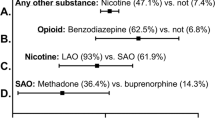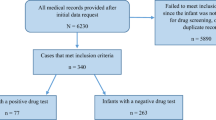Abstract
Objective:
We assessed the agreement of testing for fetal exposure to illicit drugs contrasting paired specimens of meconium vs umbilical cord tissue.
Methods:
We obtained paired samples of meconium and umbilical cord tissue from 118 pregnancies with high suspicion of illicit drug use by the mothers. Each specimen was tested for amphetamines, opiates, cocaine, cannabinoids, and phencyclidine using drug class-specific immunoassays.
Results:
The agreement of drug screening results between cord and meconium was above 90% for all drugs tested. Meconium identified 21 cases as positive for amphetamines. The paired cord identified 20 of these, and in addition identified three other positives that the meconium labeled as negative. Gas chromatography–mass spectrometry confirmed these three cord samples as methamphetamine positive. Meconium identified 97 samples that were negative for amphetamines, while the cord identified 94 of these as negative but three as positive. Agreement of cord with meconium for amphetamines was 96.6%. The concordance for opiates was 94.9%, for cocaine was 99.2%, and for cannabinoids was 90.7%.
Conclusions:
Umbilical cord tissue performs as well as meconium in assessing fetal drug exposure to amphetamines, opiates, cocaine, and cannabinoids. Results of studies using the cord may have a more rapid return to the clinician, because waiting for meconium to be passed sometimes requires several days. Moreover, in some cases the meconium is passed in utero making collection impossible, whereas cord should always be available for drug testing.
This is a preview of subscription content, access via your institution
Access options
Subscribe to this journal
Receive 12 print issues and online access
$259.00 per year
only $21.58 per issue
Buy this article
- Purchase on Springer Link
- Instant access to full article PDF
Prices may be subject to local taxes which are calculated during checkout
Similar content being viewed by others
References
http://www.healthypeople.gov/document/html/objectives/16-17.htm.
Ostrea Jr EM, Lynn SM, Wayne RN, Stryker JC . Tissue distribution of morphine in the newborns of addicted monkeys and humans. Clinical implications. Dev Pharmacol Ther 1980; 1: 163–170.
Ostrea Jr EM, Brady MJ, Parks PM, Asensio DC, Naluz A . Drug screening of meconium in infants of drug-dependent mothers: an alternative to urine testing. J Pediatr 1989; 115: 474–477.
Ostrea Jr EM, Romero A, Yee H . Adaptation of the meconium drug test for mass screening. J Pediatr 1993; 122: 152–154.
Moore C, Negrusz A, Lewis D . Determination of drugs of abuse in meconium. J Chromatogr B Biomed Sci Appl 1998; 713: 137–146.
Kintz P, Mangin P . Evidence of gestational heroin or nicotine exposure by analysis of fetal hair. Forensic Sci Int 1993; 63: 99–104.
Le NL, Reiter A, Tomlinson K, Jones J, Moore C . The detection of oxycodone in meconium specimens. J Anal Toxicol 2005; 29: 54–57.
Zweig MH, Campbell G . Receiver-operating characteristic (ROC) plots: a fundamental evaluation tool in clinical medicine. Clin Chem 1993; 39: 561–577.
Ostrea Jr EM, Brady M, Gause S, Raymundo AL, Stevens M . Drug screening of newborns by meconium analysis: a large-scale, prospective, epidemiologic study. Pediatrics 1992; 89: 107–113.
Casanova OQ, Lombardero N, Behnke M, Eyler FD, Conlon M, Bertholf RL . Detection of cocaine exposure in the neonate. Analyses of urine, meconium, and amniotic fluid from mothers and infants exposed to cocaine. Arch Pathol Lab Med 1994; 118: 988–993.
Moriya F, Chan KM, Noguchi TT, Wu PY . Testing for drugs of abuse in meconium of newborn infants. J Anal Toxicol 1994; 18: 41–45.
Buchi KF, Zone S, Langheinrich K, Varner MW . Changing prevalence of prenatal substance abuse in Utah. Obstet Gynecol 2003; 102: 27–30.
Ostrea Jr EM, Knapp DK, Tannenbaum L, Ostrea AR, Romero A, Salari V et al. Estimates of illicit drug use during pregnancy by maternal interview, hair analysis, and meconium analysis. J Pediatr 2001; 138: 344–348.
Bar-Oz B, Klein J, Karaskov T, Koren G . Comparison of meconium and neonatal hair analysis for detection of gestational exposure to drugs of abuse. Arch Dis Child Fetal Neonatal Ed 2003; 88: F98–F100.
Vinner E, Vignau J, Thibault D, Codaccioni X, Brassart C, Humbert L et al. Neonatal hair analysis contribution to establishing a gestational drug exposure profile and predicting a withdrawal syndrome. Ther Drug Monit 2003; 25: 421–432.
Moore C, Lewis D, Leikin J . False-positive and false-negative rates in meconium drug testing. Clin Chem 1995; 41: 1614–1616.
Silvestre MA, Lucena JE, Roxas Jr R, Evangelista ES, Ostrea Jr EM . Effects of timing, dosage, and duration of morphine intake during pregnancy on the amount of morphine in meconium in a rat model. Biol Neonate 1997; 72: 112–117.
Acknowledgements
The authors thank the nurses of the Labor and Delivery Unit and the Neonatal Intensive Care unit at McKay-Dee Hospital for their valuable assistance in collecting the umbilical cord and meconium specimens. This work was supported by grant R43 DAD017412.
Author information
Authors and Affiliations
Corresponding author
Rights and permissions
About this article
Cite this article
Montgomery, D., Plate, C., Alder, S. et al. Testing for fetal exposure to illicit drugs using umbilical cord tissue vs meconium. J Perinatol 26, 11–14 (2006). https://doi.org/10.1038/sj.jp.7211416
Received:
Revised:
Accepted:
Published:
Issue Date:
DOI: https://doi.org/10.1038/sj.jp.7211416
Keywords
This article is cited by
-
Agreement of umbilical cord drug and cotinine levels with maternal self-report of drug use and smoking during pregnancy
Journal of Perinatology (2011)
-
Simultaneous quantification of nicotine, opioids, cocaine, and metabolites in human fetal postmortem brain by liquid chromatography tandem mass spectrometry
Analytical and Bioanalytical Chemistry (2009)
-
Using umbilical cord tissue to detect fetal exposure to illicit drugs: a multicentered study in Utah and New Jersey
Journal of Perinatology (2008)



